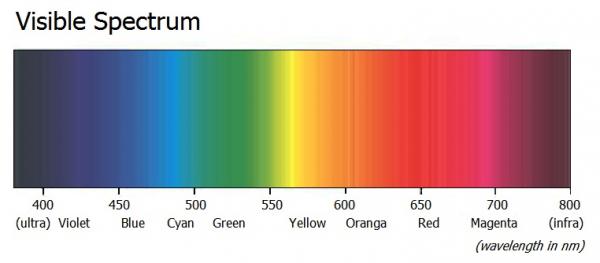1 Properties and Concepts of Light and Color
Thorough knowledge of the physical nature of light and light perception provides the foundation for a comprehensive understanding of optical measurement techniques. Yet from a practical point of view, there is little necessity to fully understand formation and propagation of light as an electromagnetic wave as long as the reader accepts wavelength as the most important parameter describing the quality of light. The human eye perceives light with different wavelengths as different colors (s. Fig. 1) as long as the wavelengths are between 400 nm and 800 nm (1 nm = 1 nanometer = 10-9 m), exactly 360 nm to 830 nm is the V(λ) and 380 nm to 780 nm for most color calculations. In the electromagnetic spectrum optical range, the wavelength is sometimes also given in Ångstrøm (Å = 10-10 m). Outside this range, our eye is insensitive to electromagnetic radiation and we therefore cannot perceive ultraviolet (UV, below 400 nm) and infrared (IR, above 80 nm) radiation.

Fig. 1: Monochromatic electromagnetic radiation of different wavelengths between 400 nm and 800 nm
causes the impression of different colors. Outside this wavelength range, the human eye is insensitive.
Source (valid as of 2002): http://www.cameraguild.com/technology/colorimetry.html
Measurements are done by either spectral measuring devices or integral measuring devices. See later chapter 2 - measurement of light with integral detectors and chapter 3 - measurement of light with spectroradiometers.